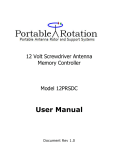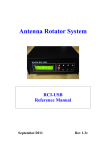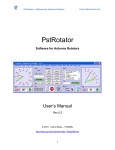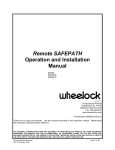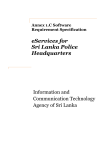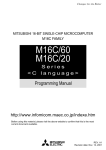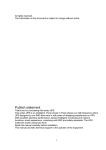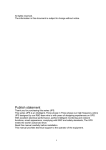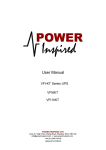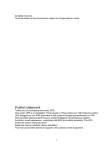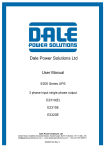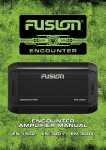Download Model 12PR1A User Manual
Transcript
12 Volt Ultra-Portable Antenna Rotor System Single Axis Model 12PR1A User Manual Document Rev 1.1 Copyright 2013-14 © Portable Rotation Patent Pending Page 1 Warranty All products sold by Portable Rotation are warranted against defects in material and workmanship for a period of 1 year from the date of shipment within North America, and for a period of one (1) year from the date of shipment to outside of North America. If you believe this product you have purchased has a defect in material or workmanship or has failed during normal use within the warranty period, please contact Portable Rotation at the below listed contact information for assistance. If product repair or replacement is necessary, the Customer will be solely responsible for all shipping charges, freight, insurance and proper packaging to prevent breakage in transit, whether or not the product is covered by this warranty. All shipments of repaired or replaced products by Portable Rotation will be F.O.B. from Roseville California, USA. This warranty does not apply to defects resulting from any Customer actions, such as mishandling, improper interfacing, operation outside of design limits, misapplication, improper repair, or unauthorized modification; breaking the Warranty Seal voids all stated warranties. No other warranties are expressed or implied. Portable Rotation liability shall be limited to the actual purchase price of any defective unit to which a claim is made, and shall in no event include the Customer's manufacturing costs, lost profits or goodwill, or any other direct, indirect, special, incidental or consequential damages whether based on contract, tort or other legal theory. Portable Rotation is not responsible for any Damage to or caused by the installed Antenna in any use case. In general: We do not warranty against Stupid ☺ Contact Information For Sales inquiries: http://[email protected] For Support: http://[email protected] Shipping Address: Portable Rotation 1214 Camino Capistrano Roseville CA 95747 Website: http://www.portablerotation.com Copyright 2013-14 © Portable Rotation Patent Pending Page 2 Contents Warranty ................................................................ 2 Contact Information ................................................. 2 Contents ................................................................. 3 Introduction ............................................................ 4 Key Features ........................................................... 4 Specifications .......................................................... 4 Limitations .............................................................. 5 Included Items ........................................................ 5 efore First Use ......................................................... 6 Installation ............................................................. 6 Operation ............................................................... 7 New Deployment Configuration ...................... 7 Set the initial Heading .................................. 7 Set the Antenna Calibration ........................... 7 Setting your Call Sign / Vanity Text ................ 8 Normal Operations ....................................... 9 Manual Turn Mode ........................................ 9 Automatic Turn Mode...................................10 Aborting an Auto Turn Operation ...................10 Rotational Stoppage – Antenna Jam ..............11 Reset to Default Settings ........................................ 11 Remote Control ..................................................... 12 3rd Party Rotor Control Software ............................. 13 Operational Details ................................................ 14 Connection Information .......................................... 15 Copyright 2013-14 © Portable Rotation Patent Pending Page 3 Introduction Thank you for purchasing the Portable Rotation 12 Volt Ultra-Portable Rotator system, Model 12PR1A. This system has been designed for the Amateur Radio Portable Enthusiast by Amateur Radio Operators who also enjoy operating portable. This system is built with a simple to use user interface allowing easy operation while still offering advanced features like ‘Auto Rotation’ and ‘Any-Direction Calibration’. The heart of the system is a microprocessor that takes user input from 3 buttons and then controls the antenna motion, displaying antenna heading and other information on a LCD screen. User entered information is saved in internal memory along with antenna heading data; the controller can be turned off when not being used to conserve power while no user or heading data is lost. Key Features • • • • • • • • • • • • Nominal rotation speed of 1RPM Easy 3 button user interface with backlight 2x8 character LCD and 2 Notification LEDs Full 360 degree rotation control – rotation stops at +/- 180 degrees from North. +/- 1 Degree Resolution PWM motor control with two user controlled turning speeds Manual antenna rotation control Automatic antenna rotation – set and forget User programmable display message ‘Any-Direction Calibration’ offering easy antenna system deployment Antenna Rotation Jam detection with auto stop 4 Conductor Rotor Cable (50 foot length provided) USB Computer interface supporting the GS232A/B Rotator Control Protocol. 40mA idle current, less than 200mA normal turning current at 12 Volts Specifications • • • • • • • • 9.0 Volt to 15 Volt DC Operation (12 Volt Nominal) 40maA idle current. Will control up to a 2 Amp motor load; provided rotor head max current is 500ma. Maximum Antenna load of 8 LBS1 Rotor Head weight: 2 lbs. 4 ounces. Provided 50 Ft Cable weight: About 1 lbs. 2 ounces. Controller Weight: 8 Ounces. (Total System weight: 3 lbs. 10 ounces). 4 conductor rotor cable – Minimum Gauge Size of 18 – Max Length supported – 100 Feet. Note 1: Super Antennas YP-3 YAGI is the largest antenna tested with; though larger than specified by the Rotor Unit, no failures happened. Copyright 2013-14 © Portable Rotation Patent Pending Page 4 Limitations The 12PR1A Rotor unit is not designed for permanent installation. The system is designed to be used for portable operations with antennas like what is sold by companies like Buddy Pole, Super Antennas and Arrow Antennas. Exceeding the specified maximum antenna weight may damage the Rotor Unit and will void all expressed or implied warranties. It is not designed to withstand long term harsh and extremely wet winter conditions. The 6 Inch long Antenna Mast found at the top of the Rotor Unit is not to be extended. A maximum length of 6 inches is recommended. Mounting a large sized antenna above 6 inches may cause premature Rotor bearing failure. Don’t: Install Antennas Heavier than 8 pounds. Operate with off center loading; make sure the antenna is balanced at the rotor mounting point. Extend the Antenna mounting shaft and mount antennas above 6 inches over the top of the Rotor Enclosure. Leave Rotor in extreme wet environments for extended times or high wind conditions. Included Items The following items are included as part of the Portable Rotator system: • • • • • • • • • 12PR1A Ultra-Portable Antenna Rotor Controller. 12PR1A Ultra-Portable Antenna Rotor Mast Unit. ‘U’ Bolt hardware to attach Rotor Unit to antenna mast. 50 Ft - 4 Conductor Cable with screw type connectors. 4 – 6 inch Velcro cable ties. 6 Foot Pigtail Power cable (2.1mm x 5.5mm, Center Pin Positive). 3 Foot USB Cable. Small Magnetic Compass. This Users Document. Copyright 2013-14 © Portable Rotation Patent Pending Page 5 Before First Use Inspect the contents of the box and verify that the contents of the box match the above list. You will need to attach a 12 Volt power source to the ends of the provided pigtail cable. Make sure to NOT cross the Positive lead with the Negative Lead. The Positive lead on the provided power cable has the White Stripe. Note: The controller electronics will work at a voltage as low as 6 Volts, but there is not enough Voltage to operate the Rotors DC motor. 9 Volt operation is not recommended when using large antennas as there is not enough energy for reliable rotation. Installation Installing the Rotor system for portable use is a straight forward task and not much different than installing your antenna without the Rotor System. Before starting the installation VERIFY that the site is in a safe location to erect an antenna system of the size you are planning. Make sure there are no overhead power wires nearby. Also make sure there are no buildings, structures, or trees that the turning antenna could strike and be damaged on. Even though this is a low power 12 volt device, the high gear ratio of the mechanism could cause damage if rotating your antenna into a fixed object. Use the provided Velcro strips to attach the feed line Coax and Rotor Cable to the mast in a few locations to keep the cables from moving in the wind. It is recommended to attach the cables to the mast in a Northerly direction so that the maximum rotation against the feed line will be 180 degrees. Remember to include a service loop in the Coax to allow for the rotation. Once the antenna/mast is up, connect the 4 conductor rotor cable to the Rotor Controller and connect 12 Volts to the Controller using the provided power cable. Take care to not cross connect the power connections. Turn on the controller, and the following start up messages are displayed with the final display showing the user configurable 8 character top line and the last known antenna heading; Portable Rotation Copyright 2013-14 © Portable Rotation Model 12PR1A PTBL RTN Dir:155 Patent Pending Page 6 Operation New Deployment Configuration After erecting your portable antenna system (including Tower/Mast, + guy lines, Rotor Head, Antenna, Feed Line and Rotor Cable) you will need to calibrate the antenna direction, and make any changes to the 8 characters of user programmable message. With the unique ‘Any-Direction’ Calibration feature of this controller, you can erect the antenna system and not worry about the antenna heading at that time. This saves time and the effort of trying to align the antenna to its proper heading while you are busy trying to secure the antenna system. Using the provided compass or other device, make note of the current heading of the antenna. Again, you do not need to have the physical antenna heading set to North or South when first erecting the antenna system; you will set the initial heading of the antenna into the controller. Set the initial Heading Use the provided Compass or other reference to get the current Antenna heading. Next go to the controller and while holding down the Mode button [Middle Button] turn on the controller. Continue holding the button until the “Entr Dir” message is displayed. Release the button. Entr Dir Dir:000 Enter New Initial Heading Using the 3 Buttons – When finished the new Heading will be displayed 20M YP-3 Dir:270 The second line of the display will have “Dir:000 “ displayed. Notice the 100’s place heading value has an underline cursor to identify the active location to change. Use the CCW [Counts Up] and CW [Counts Down] buttons to count up or down to set this value. You are allowed the value 0 through 3 in this location. When the first value is set, press the Mode button, the cursor moves to the next location; the 10’s place. Using the same procedure as before; select the value with the CCW and CW buttons and then press the Mode button when the correct number is displayed. The 1’s place value is now selected; select the value and press the “Mode” button. The current heading is now saved to memory and the new heading is displayed. If you make an error, just redo the process by Power Cycling the controller. Set the Antenna Calibration The Rotor controller will try to stop the rotation on the exact degree position when turning in the Automatic Mode or when in Remote Control Mode. It the Rotor misses the stop location by more than 1 degree, you can try to adjust the system response by setting the Antenna calibration to Optional (Opt). To set the Controller to and from the Optional calibration mode, do the following; while holding down the CW button [right Button] turn on the controller. Continue holding the button until the “Ent ACal” message is displayed. Release the button. Copyright 2013-14 © Portable Rotation Patent Pending Page 7 The value “Nml Opt” is displayed on the bottom line. Press the “CCW” button for a Normal (Default) operation, or “CW” button for the Optional Antenna Calibration. The “MODE” button has no effect in this operation. The Controller will display your choice for a few seconds, then return to the normal operating mode. Ent ACal Turn On while Holding the CW Button Ent ACal Nml Opt Release the CW Button and then press the CW Button to select Ent ACal Opt Ant Selected Opt Antenna is displayed for 2 seconds Setting your Call Sign / Vanity Text The 12PR1A Rotor Controller allows you to set and will display during idle time where the controller is not turning the antenna, 8 Characters of your choice on the top line. This can be your call sign, antenna information, or any other message you want displayed. This information can be changed as often as you like. The process of setting the text message is similar to setting the initial antenna heading. While holding down the CCW button [left Button] turn On the Controller. Continue holding the button until the “Ent Call” message is displayed, then Release the button. The bottom line will now display the current message text and the first character position will show that it is ready for input as it will be underlined. Use the CCW and CW buttons to step forward or backwards through the Letters and Numbers, pressing the MODE button after the correct character is selected. You must do this operation for all 8 character positions. If no change is needed, just press the MODE button to move to the next character. After entering all 8 characters the display will refresh showing the new user selected text on the top display row and the current antenna heading on the bottom. Copyright 2013-14 © Portable Rotation Patent Pending Page 8 Normal Operations Once the initial configuration is complete, the 12PR1A Rotor Controller is ready to turn your antenna to a new heading. As with most HF/6M/VHF/UHF beam type antennas that this controller is designed to work with, exact degree accuracy is not needed. A heading error of 15 degrees or even more will probably not make a difference in your signal. There are Three modes of operation; 1) Manual Turn, 2) Automatic Turn, and 3) Remote Control. Manual Turn Mode To use this mode of operation, press and hold the CCW (Counter Clockwise) button or the CW (Clockwise) button until the heading on the LCD display Shows the heading you want. This will cause a full speed turn so remember to lead the turn by a few degrees; releasing the button before the exact heading is displayed. You can do a half speed turn by pressing the mode button and holding it at the same time as you press the CW or CCW button. During any turn operation the GREEN LED is on indication that a turn is in progress. The controller is designed to not let you rotate past 180 degrees during either a CW or CCW turn operation. This is to keep the antenna feed line from ‘wrapping’ around the mast. When the turn reaches the heading of 180 the turn is stopped and you are informed that you have reached the virtual hard stop with an LCD message. When reaching the “MAX TURN” limit of 180 degrees, a message is displayed and turning in that direction is blocked. The only turn allowed is in the opposite direction. The degree symbol is replaced with an arrow to indicate the only direction of turn allowed. Pressing the opposite direction control button will clear the MAX TURN message as the antenna turns away from the 180 degree maximum turn position. During all turn operations, a short pause of 3 seconds is inserted from when you release the turn direction button and when you can start a new turn. This allows the antenna system to ‘settle’ at its new heading. Copyright 2013-14 © Portable Rotation Patent Pending Page 9 As a turn is in process, the new heading value is saved to memory. When finished with your turn, to save on battery power until the next time you want to turn the antenna, you can turn off the Controller to conserve station power. Automatic Turn Mode This mode of turning to a new heading is useful when you need to make a large antenna heading change; As an Example: Turn from 170 degrees to 190 degrees, (340 degrees). You can either hold the “CCW” button down for the duration of the turn or you can enter the Auto Turn Mode, input the new heading and let the controller manage the turn for you. Remember a turn through 180 degrees is not allowed by the controller. To enter the Auto Turn Mode, with the control unit on, press and hold the MODE button for 1 second. When you see the message “AutoTurn” in the display release the button. You will enter the ‘Turn to Heading’ by the same method used when setting the antenna heading calibration. You will see on the second line of the display the message “Dir:000 “. Notice the 100’s place heading value has an underline cursor to identify the active location to change. Use the CCW [Counts Up] and CW [Counts Down] keys to scroll up or down to set this value. You are allowed 0 through 3 in this location. When the first value is set, press the Mode button, the cursor moves to the next location; the 10’s place. Using the same procedure as before; select the value with the CCW and CW buttons and then press the Mode button when the correct number is displayed. The 1’s place value is now selected; select the value and press the Mode button. The ‘Auto-Rotation’ will start and the controller will automatically turn the antenna to the new heading. When the turn is completed, the new heading value is saved to memory and you can turn off the controller to save on battery power until the next time you want to turn the antenna. The current antenna heading is displayed during the turn. Aborting an Auto Turn Operation At any time during the Auto Turn process, you can abort the turn by pressing the MODE (Middle button). The turn will stop immediately saving the current heading to memory. Copyright 2013-14 © Portable Rotation Patent Pending Page 10 Rotational Stoppage – Antenna Jam In the event that during the rotation of the Antenna, it comes into contact with a structure, tree, or other unmovable object that stalls the turn for more than 1 second, the Controller will detect that the turn has stopped and will turn off the motor, display a message on the LCD and turn on the RED led with a constant ON condition. If a Rotational Jam does occur, stop any further attempts at antenna rotation and go inspect the antenna site. The drive motor is relatively small but has a very high gear reduction, and when operating from a 12 source can produce enough torque to possibly damage a light duty antenna. To clear the condition after you have resolved the physical condition causing the Antenna Jam, you can rotate the antenna in the opposite direction that caused the JAM or power-cycle the Controller. Reset to Default Settings The controller can be reset to the default out of box settings, clearing any user entered settings and resetting all internal stored states. To reset the Controller, turning on the unit while holding down all 3 buttons until the sign on messages are displayed. The Firmware Version will be displayed and you will be asked if you want to reset the Controller. Press the CCW button for Yes or the CW button for No. If yes the controller then returns to normal operation, with factory defaults. If the controller is experiencing erratic operations in heading reporting or other operations, perform the above Reset operation. Copyright 2013-14 © Portable Rotation Patent Pending Page 11 Remote Control The Rotor Controller can be attached to a computer system using the USB Type-B jack on the front of the Controller. The controller supports the GS232A/B Rotator Control Protocol. Serial Parameters supported are: 9600 baud, 1 Start, 1 stop, No Parity, No Handshake In this protocol the following Commands are supported: Start Left Turn: Start Right Turn: Stop All Turn: Auto Turn to new Heading: Report Current Heading: L Command R Command A or S Command M=XXX Command C Command and replies with ‘AZ=XXX<CR>’ To enter the Remote Control mode of operation, with the controller on, press and hold both the CW and CCW buttons. The display will show the following message: The ‘Antenna Jam’ Red LED will flash each time the controller receives a command from the host computer. While in the Remote Control Mode, manual control of the rotor is disabled. To exit the Remote Control mode, Press both CW and CCW buttons a second time. To use the onboard USB interface your computer needs to have the FTDI Virtual COM Port driver loaded. This driver is available on the FTDI Web Site at the following URL: http://www.ftdichip.com/Drivers/VCP.htm From this location select the driver based on you Operating System and install as instructed by FTDI. Copyright 2013-14 © Portable Rotation Patent Pending Page 12 3rd Party Rotor Control Software There are a number of applications on the market that can be used to Remotely Control the 12PR1A Ultra-Portable Rotor system. One such program is called ‘PstRotatorAz’ and is sold by YO3DMU. It is a full featured Windows compatible application that will run stand alone or as an interface between other applications. Website: http://www.qsl.net/yo3dmu/index_Page346.htm After installing the software and entering your registration code you must configure the software by setting the COM Port and Controller Type. Under the ‘Communications’ Tab – Select ‘AZ COM Port’ and select the USB Port that the Controller is attached to. Under the ‘Setup’ Tab: - Select ‘Controller’ and select ‘GS-232 Yaesu 360 deg’ - Select ‘Refresh Rate’ and set to 1 Sec - Select ‘Start in Manual Mode’ - Select “Antenna Limits’ and set as follows: There are many other settings that can be set based on user needs. The ones listed are minimum needed to enable this software for this controller. We have tested this application on Windows XP, Windows 7 32-Bit and Windows 7 64-Bit and the USB driver listed on page 15 with no problems found. The USB Port is powered by the Host PC so you can turn off the Controller and the USB port will not be dropped by the attached controller Copyright 2013-14 © Portable Rotation Patent Pending Page 13 Operational Details The diagram below can be used as a reference to the basic turning operation of the Rotor System. Port Rtn Dir : 000 When the antenna Heading is between 359 degrees North and 180 Degrees Aouth, turning the antenna to the East requires a Clockwise (CW) turn. You cannot turn Counterclockwise (CCW) and pass through 180 degrees South. When the antenna Heading is between 000 degrees North and 180 degrees South, turning the antenna to the West requires a Counterclockwise (CCW) turn. You cannot turn Clockwise (CW) and pass through 180 degrees South. 359|000|001 NORTH WEST 270 Antenna Direction EAST 090 SOUTH When at a South-South-West heading and turning to a SouthSouth-East heading use the ‘Auto Turn’ feature to turn the antenna. When at a South-South-East heading and turning to a SouthSouth-West heading use the ‘Auto Turn’ feature to turn the antenna. 180 / 180 MAX TURN Dir:180 Copyright 2013-14 © Portable Rotation MAX TURN Dir:180 Patent Pending Page 14 Connection Information The rotor cable is a 4 conductor, 18 Gauge, 7 strand cable using female connectors at each end. Pin Pin Pin Pin 1 2 3 4 to to to to Pin Pin Pin Pin 1 2 3 4 – – – – Motor (+/-) Motor (-/+) Sensor (+) Sensor (-) Below are the connection details for the Rotor Controller to Rotor Head Connection. Required Cable Connector: 4-Pin MIC connector: Philco P61605 An extension cable will require 1 4-Pin male and 1 4-Pin female connection. Cable length over 100 feet are not supported. An optional 50 Ft extension cable can be purchased from Portable Rotation. Caution should be used if making your own cable as connecting the Motor Drive pins to the rotational sensor may damage the controller and require replacement of the Controller and/or the Rotor Unit. Copyright 2013-14 © Portable Rotation Patent Pending Page 15















